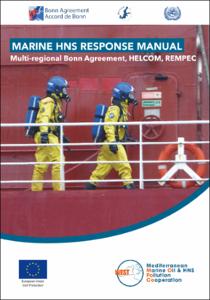| dc.contributor.author | Alcaro, Luigi | |
| dc.contributor.author | Brandt, Julke | |
| dc.contributor.author | Giraud, William | |
| dc.contributor.author | Mannozzi, Michela | |
| dc.contributor.author | Nicolas-Kopec, Annabelle | |
| dc.date.accessioned | 2023-07-20T19:29:37Z | |
| dc.date.available | 2023-07-20T19:29:37Z | |
| dc.date.issued | 2021 | |
| dc.identifier.citation | Alcaro L., Brandt J., Giraud W., Mannozzi M. and Nicolas-Kopec A. (2021) Marine HNS Response Manual Multi-regional Bonn Agreement, HELCOM, REMPEC. Project WestMopoco, 321pp. DOI: https://doi.org/10.25607/OBP-1933 | en_US |
| dc.identifier.isbn | 978-2-87893-129-7 | |
| dc.identifier.uri | https://repository.oceanbestpractices.org/handle/11329/2324 | |
| dc.identifier.uri | https://doi.org/10.25607/OBP-1933 | |
| dc.description.abstract | Maritime transport is often described as
“the backbone of globalized trade and the
manufacturing supply chain”, since more
than 80% of the global merchandise trade
by volume is carried by sea.
Some of the goods transported are
defined as Hazardous and Noxious Substances
(HNS). HNS might be released
into the sea as the consequence of illegal
discharges or maritime accidents such as
groundings or collisions; and whilst major
incidents involving an HNS spill are rare,
they can be very complex and potentially
have severe impacts on human health,
the environment, and socio-economic
resources. The particular challenges associated
with responding to HNS incidents
are linked to the heterogeneity of the
various substances considered as HNS,
which include substances presenting
various hazards (physical hazards such as
fire and explosion, health hazards such as
toxicity, and environmental hazards) and
behaviours (gases/evaporators, floaters,
dissolvers, sinkers).
The objective of this Marine HNS Response
Manual is to provide operational guidance
for first responders and decision-makers
during a maritime incident at sea or in port involving HNS. The manual does not cover
all aspects of an incident involving HNS,
but specifically addresses relevant offshore
and onshore spill response techniques
(but excludes topics such as search and
rescue, salvage, medical treatment). The
HNS Marine Response Manual consists of
three parts:
1. Introductory background information
relevant for understanding the concepts
driving an HNS response strategy in
seven chapters;
2. Operational fact sheets and decision-
making flowcharts relevant for responders;
3. Annexes I, II and III include regional
specificities (information on maritime
transport, sensitive resources, etc.) for
the Baltic Sea (Helsinki Commission
(HELCOM)), North Sea (Bonn Agreement)
and Mediterranean Sea (The
Regional Marine Pollution Emergency
Response Centre for the Mediterranean
Sea (REMPEC)) respectively. | en_US |
| dc.description.sponsorship | European Union Civil Protection | en_US |
| dc.language.iso | en | en_US |
| dc.publisher | Project WestMopoco | en_US |
| dc.subject.other | Hazardous substances | en_US |
| dc.subject.other | Spill response techniques | en_US |
| dc.subject.other | Transportation | en_US |
| dc.title | Marine HNS Response Manual: Multi-regional Bonn Agreement, HELCOM, REMPEC. | en_US |
| dc.type | Report | en_US |
| dc.description.status | Published | en_US |
| dc.format.pages | 321pp. | en_US |
| dc.description.refereed | Refereed | en_US |
| dc.subject.parameterDiscipline | Human activity | en_US |
| dc.description.currentstatus | Current | en_US |
| dc.description.sdg | 14.1 | en_US |
| dc.description.maturitylevel | Mature | en_US |
| dc.description.adoption | Multi-organisational | en_US |
| dc.description.adoption | International | en_US |
| dc.description.methodologyType | Method | en_US |
| dc.description.methodologyType | Specification of criteria | en_US |
| obps.endorsementAuthorDeclared.deJureStandard | HELCOM | |
| obps.resourceurl.publisher | www.westmopoco.rempec.org | |
 Repository of community practices in Ocean Research, Applications and Data/Information Management
Repository of community practices in Ocean Research, Applications and Data/Information Management
